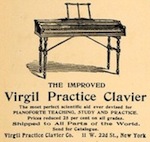![]() Find out the interesting things which have been happening in the world of aural skills development and ear training. Have we missed any?
Find out the interesting things which have been happening in the world of aural skills development and ear training. Have we missed any?
Jump to:
- Making Time for Improvisation
- The most relaxing song ever created?
- Silent Practice: The Art of Inner Listening
- Free Jazz Visualisation eBook
- Why Sound?
Making Time for Improvisation
In the post “Making Time for Improvisation” Joy Morin recently advised teachers to “encourage the student to play whatever sounds good to them” and provided some examples of simple exercises which can be used to draw out the student’s creativity at the keyboard.
In piano lessions today, improvisation is often a subject that often “goes out the window” because it is deemed to be less important or secondary to other skills. It had not always been this way; improvisation used to be a expected skill for any accomplished keyboardist during the Baroque through Romantic eras. Interestingly enough, it seems that today, the role of the pianist has evolved into the role of reproducing the works of other composers, rather than being a pianist-composer.
Teaching improvisation in the lesson can be an incredibly useful tool, as well as serve as a creative outlet for the student. How do we, as piano teachers, find or make time to teach students how to improvise at the piano?
The most relaxing song ever created?
The band Marconi Union have worked together with the British Academy of Sound Therapy to produce a track (for Radox Spa, a bubble bath company) to try to create the world’s most relaxing song. It’s called Weightless and you can listen here:
The techniques reportedly used to make the song relaxing are:
- It contains a sustaining rhythm that starts at 60 BPM and gradually slows to around 50. While listening, your heart rate gradually comes to match that beat. It takes about five minutes for this process, known as entrainment, to occur.
The fall in heart rate also leads to a fall in blood pressure.
The musical intervals have been chosen to create a feeling of euphoria and comfort. - There is no repeating melody, which allows your brain to completely switch off because you are no longer trying to predict what is coming next. Instead, there are random chimes.
- The final element is the low, whooshing sounds and hums that are like buddhist chants.
Give it a listen and see what you think.
Personally, I found it somewhat relaxing, but far too active to really let me switch off. In fact, it’s a superb track for practising active listening. Musically, there’s such a hodge-podge mix of stuff going on, you can continually re-focus your ear’s attention on different elements, and practise following instruments or parts, or hearing multiple elements in parallel.
If you just listened in a relaxed way the first time, give it another play and try to listen carefully to all the different elements at work here. Science apparently tells us they should encourage our bodies to relax, but one could definitely argue the opposite is true musically! Leave a comment below and share your opinion.
Silent Practice: The Art of Inner Listening
A pianist’s tribute to his silent practice instrument, the “Virgil Practice Clavier”. Author Graham Fitch writes about how useful a device this was to develop his fingering, allow extra practice, suggest new exercises, and most of all improve his auralisation and sensitivity.
I was able to hear in my head the sounds my fingers would have been making, and in some ways this made me listen more. I was never troubled by hearing any wrong notes, and I wasn’t preoccupied with tone, balance and sound in the way that most of us pianists are most of the time. I could imagine the perfect sound in my inner ear and never have this disturbed.
Have you ever tried silent practice on your instrument? Have you spent time in Mental Play? These can both be very effective ways to develop your mind’s ear and improve your musicianship – all without making a sound!
Free Jazz Visualisation eBook
Though it focuses on visualisation, the new eBook available for free from JazzAdvice.com has some great information and guidance on developing your aural skills, as part of their recommended approach to learning jazz improvisation.
If you’re not happy with the sound you have right now, instead of looking at external sources, study the sound inside of your mind.
Start by visualizing your ideal sound on your instrument. Put on a recording of your favorite player, someone that you wish you sounded like. As you’re listening to the recording, close your eyes and imagine that it’s you that is playing; visualize what it would feel like to produce that incredible sound and ingrain it into your mind. The next time you pick up your instrument, recall this sound and feeling and I guarantee that your sound will have a new energy to it.
Visualisation (vividly imagining yourself performing the way you want to) can be a powerful factor in successful musical development, and this book teaches how to combine a score-based visualisation technique with the aural imagination required to perform well – and even overcome anxiety and doubt when playing live.
Why Sound?
Finally this week, an inspiring and uplifting video from the folks at Soundcloud.com, all about the power and wonder of sound, featuring Moby, Martyn Ware, Imogen Heap, and more:
“Sound” from SoundCloud on Vimeo.








